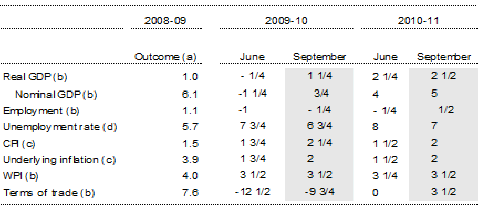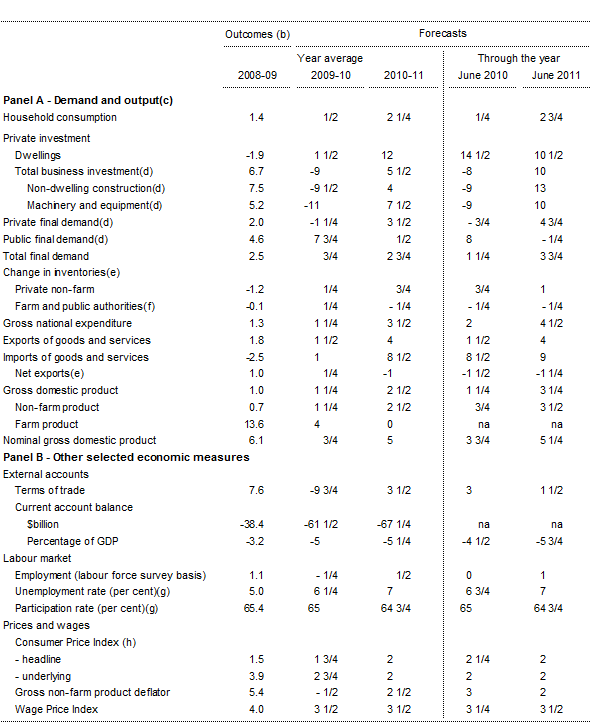The Australian economy has performed better than expected in recent months. This reflects more robust underlying conditions and a stronger than expected response to the fiscal stimulus and lower interest rates, which have bolstered confidence to a surprising degree. Stronger demand from China has supported Australia's commodity exports, causing our exports to grow despite a global contraction in trade volumes. This has improved the outlook for the mining sector and is expected to flow through to stronger investment outcomes, with a number of larger engineering construction projects now looking more likely to proceed.
World output is now expected to decline by 1¼ per cent in 2009 (previously 1½ per cent), reflecting the contraction that has already taken place during the first half of the year. Growth in 2010 has been revised upwards from 2¼ to 3¼ per cent, with slightly stronger growth expected amongst Australia's major trading partners.
Accordingly, the September round forecasts for the Australian economy have been revised upwards since the June update. Real GDP is now expected to grow by 1¼ per cent in 2009-10, compared to a ¼ per cent contraction forecast in June, while the growth forecast for 2010-11 is a little stronger at 2½ per cent. As a result of the improved outlook, the unemployment rate is now expected to peak at 7 per cent, one percentage point lower than expected in June.
Table 1: Key Domestic Forecasts – September compared with June

(a) Calculated using original data.
(b) Year average
(c) Through the year growth rate to the June quarter.
(d) June quarter
Australia has continued to grow despite the global recession and is the only advanced economy to have recorded positive growth through the year to June 2009. After the severe contraction recorded during the December and March quarters, the world economy appears to have stabilised. A recovery is underway in our Asian trading partners, with key regional economies rebounding strongly over the past six months. In particular, China has continued to perform better than expected, with domestic demand supported by aggressive monetary and fiscal policy stimulus. There also appear to be tentative signs of a bottoming in GDP in advanced economies, most notably the United States.
While news on the global economy has improved, conditions are expected to remain weak over the next year (and beyond) as the major advanced economies deal with the legacy of weak financial systems and deleveraging. Challenges therefore remain for the Australian economy. Timely support from macroeconomic stimulus will remain important to maintaining activity until a more sustained recovery in private sector activity takes hold.
The continued strength in Chinese demand has helped support Australia's export volumes, which are now expected to grow by 1½ per cent in 2009-10, compared to a contraction of 2½ per cent forecast in the June update. In particular, demand for non-rural commodities has remained robust, supported by Chinese demand associated with that country's stimulus measures.
The terms of trade are expected to fall by 9¾ per cent in 2009-10, principally reflecting declines in contract prices for bulk commodity exports that are already largely locked in. The fall has been tempered somewhat since the June round by increases in spot commodity prices and the short term effects of a higher Australian dollar. The terms of trade are expected to recover somewhat in 2010-11 as the recovery in world growth bolsters commodity export prices.
The outlook for business investment has improved since June, with recent business surveys suggesting that businesses are becoming increasingly optimistic about their future prospects. However, overall business investment is still expected to contract by 9 per cent in 2009-10 and the outlook is markedly different amongst the different components of investment. Engineering construction is expected to grow strongly in 2010-11 as a number of major resource projects ramp up, most notably the Gorgon Liquefied Natural Gas project. In fact, the potential scale of these projects represents a key upside risk to the broader growth outlook. However, non-residential construction is expected to decline by 23½ per cent in 2009-10 as on-going credit constraints and higher vacancy rates continue to weigh on the sector. Plant and equipment investment is expected to contract as the effects of tax concessions unwind before staging a gradual recovery in line with the recent rebound in business confidence.
The Government's cash payments to households and historically low interest rates have continued to support household consumption. Some near term weakness in household consumption is expected as the impact of the cash payments unwinds. However, robust consumer confidence, a smaller rise in unemployment and the sustained recovery in asset prices should support household consumption through calendar 2010.
The public sector will be an important source of activity in the near term as a range of infrastructure projects associated with the Government's stimulus packages come on line. The forecasts for public sector activity are driven by expected profiles for spending under the stimulus packages, which have been updated on the basis of progress reports from the states and territories and the Office of the Coordinator General. This exercise has suggested some slippage in the expected timing of activity, with more activity from the infrastructure packages now expected to be in the first half of 2010.
The possibility of further slippage in public infrastructure activity is a key risk to the forecasts. The data available to assess the progress of the States and Territories spending in these areas are incomplete. While it is a relatively straightforward task to monitor funds being transferred to the States and Territories, so far it has proven more difficult to translate this to activity ‘on the ground'.
The decline in dwelling investment is expected to have bottomed during the June quarter, after which it will contribute to growth. Recent increases in housing finance and building approvals suggest a recovery in this sector is imminent. Increased consumer confidence, low mortgage interest rates and strong population growth all support recovery in this sector. However, downside risks remain, notably the prospect of monetary policy tightening and the withdrawal of the First Home Owners Boost.
Given the stronger outlook, the contraction in employment is expected to bottom in late 2009, with the peak unemployment rate of 7 per cent in the December quarter of 2010. In the current downturn, employers have reacted to lower domestic demand more by reducing hours than shedding jobs. An unwinding in the drop in average hours worked is expected as labour market conditions improve.
Underlying inflation is forecast to be stronger than forecast in the June update in line with a stronger economy, only partially offset by the effect of a higher exchange rate on import prices. Underlying inflation is expected to be 2 per cent through the year to June in both 2009-10 and 2010-11.
Overall, the September round forecasts reflect a more positive outlook than in June. This is in large part due to the continued resilience of the household sector and export volumes, reflecting the success of policy stimulus measures to date - both in Australia and amongst our trading partners. A significant amount of uncertainty remains concerning the sustainability of the global recovery and the degree of strength in underlying demand as policy stimulus is withdrawn.
Moreover, there is a need for caution in interpreting recent outcomes given the conflicting messages evident in the ABS data. The production and income based measures of
GDP in the National Accounts suggest the economy contracted over the year to June 2009. The expenditure-based measure suggested the economy grew by nearly 3 per cent. There is therefore the possibility of the starting point for these forecasts looking very different after the ABS has the opportunity to revise the data. The ABS will seek to resolve differences in the various measures of GDP in future National Accounts releases.
Table 2: Domestic economy forecasts (a)

(a) Percentage change on preceding year unless otherwise indicated.
(b) Calculated using original data.
(c) Chaine volume measure.
(d) Excluding second-hand asset sales from the public sector to the private sector, and adjusted for the privatisation of Telstra.
(e) Percentage point contribution to growth in GDP. (f) For presentation purposes, changes in inventories held by privatised marketing authroities are included with the inventories of the farm sector and public marketing authorities.
(g) The estimates in the final two columns are the forecast rates in the June quarter in 2010-2011 respectively.
(h) Through the year growth rate to the June quarter for 2008-09.
Source: ABS Cat. No 5206.0, 5206.0, 5302.0, 6202.0, 6345.0, 6401.0, unpublished ABS data and Treasury.